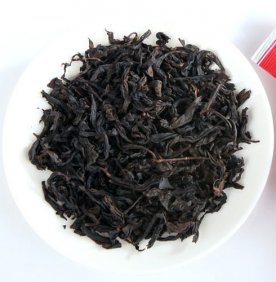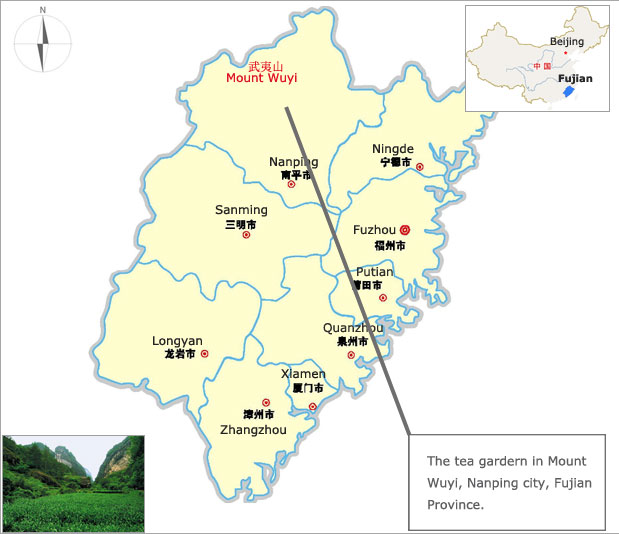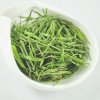Da Hong Pao InformationSummary
Da Hong Pao
Other names: Big Red Robe The origin of the nameDa Hong Paoo tea is so called because of an interesting history. In Ming Dynasty Hongwu 18 years (1385), Fujian Juren (a provincial graduate) Ding xian went to Beijing for the imperial examinations. When passed by the Wuyi Mountains, he suddenly got an unbearable pain in the stomach. At this time, he bumped into a buddhist monk from Tianxin Yongle Temple. The monk took out if the scare Da Hong Pao tea and made a cup of tea for him. After drinking, the pain was missing. Sitting the champion, Ding xian went back to thank the monk and took the Da Hong Pao tea in tin cans back to the capital—Beijing. When he arrived at the capital, he heard the queen was ill and all the imperial doctors had no method to cure. He took out of that pot of tea to the empress. The empress kept drinking and recovered gradually. Hearing these, the emperor was very happy. He awarded a red robe to the tea tree and sent the champion back to the Kowloon ke to put the robe on the tree. After that, the emperor sent some guards to look after the trees and pluck the tea leaves. Since then, all the teas were just provided to the royal enjoy and forbidden for private use. It’s said annually the officials sent by the empire wore the red robe and took off it to put on the trees. So we now call it Red robe tea (also Da Hong Pao in Chinese). Production AreaDa Hong Pao tea is mainly produced in Wuyi Mountains located in the southeast of Fujian province. Here is one place of the famous production areas of Chinese teas. And Da Hong Pao grown in the Kowloon ke’s cliff of Wuyi Mountains is called the parent Da Hong Pao. Its output is less than 500 gram annually. So the price is expensive and it’s not on sale in market generally. 
Location of Mount Wuyi in China FeaturesThe appearance of Da Hong Pao tea is cable and tight knot. The tightly twisted leaves of Da Hong Pao are greenish brown in color. After infusions, the bright orange tea liquid comes with strong floral fragrance and the leaves are red and green. The most prominent quality of Da Hong Pao is that the tea liquid is full of the sweet smell like Orchids and the smell lasts for a long time. "Rock rhyme" is obvious. Especially, even after 7-8 infusions, the floral fragrance still remains. Processing technologyThe collection and processing of Da Hong Pao tea are much more sophisticated. Every spring, 3-4 newborn leaf shoots are picked. Through sunning dry, cooling blue, doing green, fried, first rubbing, re-fried, re-rubbing, water baking, toss sorting, cooling, sorting tick, re-baking, re-toss sorting, re-drying and so on process, the final product teas are made. Brief Health Info1、Improvement on immunity: The tea can improve the CONA to stimulate spleen lymphocyte proliferation response, increasing the body's resistance.
4、Dental health care: The fluoride content in tea is 27.3-146.6 PPM. The appropriate fluoride can prevent tooth decay and enhance the tenacity. Brewing methodIn order to taste the Da Hong Pao tea well, we advise to follow the process of tasting congou tea, which is using small pot and cup to drink carefully and slowly, so that you can really feel the flavor of yancha. More info about Brewing method. Quality identificationIt should identify from several areas, such as appearance, liquor color, aroma, taste, brewing numbers and bottom of leaf, in which the aroma and taste are the more important point. Appearance: Dry tea’s shape and color can be used as a reference to quality identification. Usually its shape is cable, tightly knot and slight twisted. And stale tea owns a gray brown color. If its shape is incomplete cable or the tea is broken, it must be inferior. Besides, the bottom of the leaf can also be used as a reference. It should softly bright and its edge is obviously red.
High-quality tea should have no apparent bitterness, texture (sticky and consistency in mouth), lubrication, significantly sweet, memorable enough (Beginners are difficult to grasp this characteristics of the Rock rhyme). Tea storageDa Hong Pao tea is preferred not to use glass jars, porcelain pots, boxes or medical bottles to preserve. Because these apparatuses have some shortcomings: fragile, pervious to light and not moisture-proof. It’s recommended to use dry jar or refrigerator to protect the tea. More info about Tea storage of Chinese tea. |
- Company Info
- About Us
- Chinese Tea Wholesale
- Site Map
- Links
- Customer Service
- My Account
- Chinese Tea Forum
- Contact Us
- Live Chat
- Company Policies
- Payment Methods
- Shipping Guide Return Policy
- Privacy Policy
- Terms of Use




